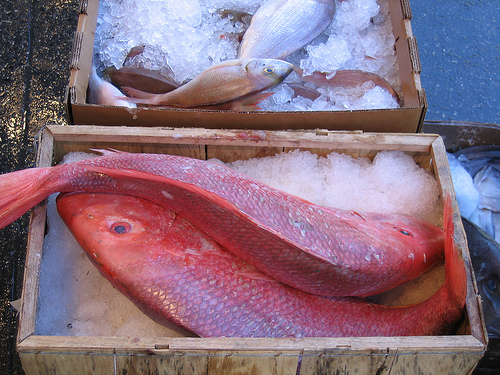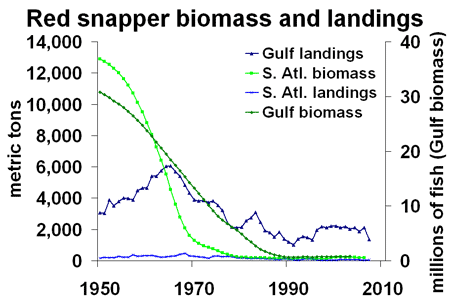 Endangered species for sale Photo: MaRonin47
Endangered species for sale Photo: MaRonin47
I’m a big fan of Mark Bittman. I’ve been reading him since his Cook’s Illustrated days in the early ’90s; I consider his weekly “Minimalist” column in The New York Times invaluable; and several of his cookbooks sit, stained and dogeared, on my shelf. Bittman made a career by slicing through pretensions about cooking as an art best left to professionals or the leisure class. Long before it became fashionable, Bittman demonstrated that cooking from scratch can be a quotidian activity. All it takes, he has preached again and again, is a few decent ingredients, some basic kitchen equipment, and some quite learnable skills and principles. (Here’s a classic Bittman piece on how to outfit a high-functioning home kitchen without blowing $500 on a single pan.) The importance of such thinking is immense. Farmers markets, CSAs, and other sustainable-food institutions could not have arisen over the past two decades without a growing horde of people who feel empowered to cook. The farm-to-plate trend might have peaked long ago, if people felt that cooking meant 20-ingredient, epic recipes that required the use of $150 chef’s knives. Bittman has been an important figure in debunking that myth — and done so without nudging people to rely on packaged, processed foods in their cooking, as certain TV cooking-show stars have.
Further, I salute Bittman’s recent critiques of the industrial food system, summed up in his book Food Matters: A Guide to Conscious Eating.
For all of these reasons, it pains me to call him out on something in his recent Minimalist column, which features a delicious-sounding recipe for fruit salsa with red snapper — one of the most endangered species in U.S. waters. I know I sound like a former smoker now spewing hellfire and damnation at the unsaved. (My conversion moment was reading Teras Grescoe’s Bottomfeeder.) But I believe that influental food writers, especially ones concerned with conscious eating, need to start educating the public about the dismal state of the oceans.
A couple of weeks ago, I chided Bittman’s colleague, NYT culture editor and sometime food writer Sam Sifton, for something similar. But even though Sifton published a recipe calling for endangered fish, he at least made distinctions. Sifton explicitly went looking for “fresh” fish caught “out in the cold waters off Montauk.” There’s an implicit message here: buy what’s in season from your local fishermen — a generally much more sustainable way to go about things than buying what turns up at the supermarket from industrial fisheries. Of course, lots of folks in the U.S. don’t live near the sea or have access to local fishermen — hence my ire at Sifton for not raising sustainability issues.
Bittman, however, makes no distinctions about snapper. According to the National Marine Fisheries Service, the red snapper fishery streches from North Carolina, around the Florida coast, and all the way down the Gulf of Mexico. They can live upwards of 50 years. Here’s the bad news: the breeding population of red snapper stands at 6 percent of target size in the Gulf, and 3 percent off the Atlantic coast of southern states. In other words, if present trends continue, we could be the last generation that gets to eat this admittedly delicious fish.
Bittman calls for red snapper in his recipe without comment. In the accompanying article, he makes this remark: “I have served xec [a Mayan fruit] with poached shrimp, sautéed skate, grilled swordfish and roast tuna. They were all terrific.”
And all problematic. Take shrimp — once a seasonal treat, now everyday fare for Americans. A few years ago, shrimp surpassed canned tuna as the most-consumed U.S. seafood product. “Today, 90 percent of our shrimp—more than 1 billion pounds a year—come from foreign farms,” writes Jim Carrier in an excellent recent piece in Orion. In Bottomfeeder, Teras Grescoe puts it like this: “The simple fact is, if you’re eating cheap shrimp today, it almost certainly comes from a turbid, pesticide- and antibiotic-filled, virus-laden pond in the tropical climes of one of the world’s poorest nations.” Lest anyone think otherwise, these factory farms contribute to poverty in the nations that house them, as Grescoe demonstrates; they privatize and cut down highly productive mangrove forests that once sustained fishing communities, leaving fetid dead zones in their wake.
Skate? Don’t go there. Here is Monterey Bay Aquarium’s Seafood Watch:
Skates have been severely overfished and most are caught with bottom trawls, which result in high levels of accidental catch and substantial damage to the seafloor.
Swordfish can be a good choice, according to Monterey Bay, but people should be aware that it’s a top feeder that bioaccumulates alarming amounts of mercury.
As for tuna, most species (excluding bluefin) are okay to eat in terms of sustainability, but, like swordfish, tuna tends to carry a heavy mercury load. (Environmental Defense has a list of fish to watch out for in terms of mercury and PCBs).
My point is: at this point, societies need to make serious decisions about what seafood is consumed and how we farm it. If we don’t, we risk losing the sea as a vital food resource. Influential food writers can’t force the issue themselves — ultimately, we’ll need coordinated government action across the globe — but they have considerable power to point consumers in the right direction The time has come to use it.
Doing so needn’t mean turning every article on seafood into a lecture on fishery trouble. Seafood Watch offers a robust resource for making sound distinctions when cosndering which fish to buy — including alternatives to red snapper.



